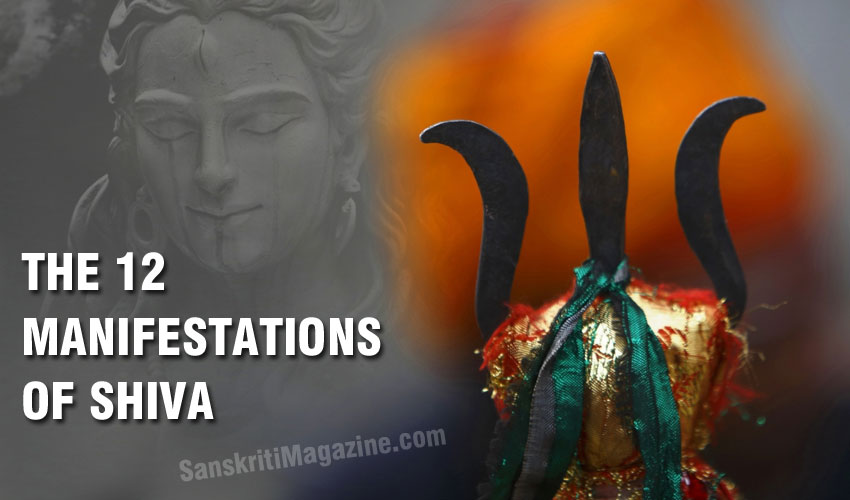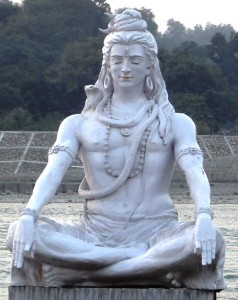According to Hinduism, during the Puranic Age, Gods and Goddesses were glorified as supreme beings in various eulogizing texts full of amazing stories – in the Puranas.
In the Shiva Purana, Lord Shiva is celebrated in the five elements of Nature governed by him – Earth, Water, Fire, Air, and Space. Each of these elements is symbolized and worshiped in the form of a Linga, the formless form of Shiva.
The Shiva Purana also mentions 64 manifestations of Lord Shiva. Prof. K. Venkatachari, a noted artist, in his book Manifestations of Lord Shiva, brings to life a dozen such manifestations through beautiful illustrations.
Below are 12 manifestations of Lord Shiva:
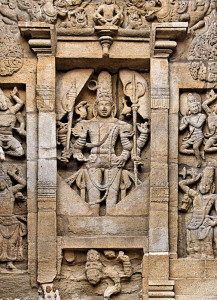 Lingodbhava – The immeasurable one
Lingodbhava – The immeasurable one
A four-armed Shiva avatar standing upright and very tall, holding an axe and an antelope in his upper arms and the forearms poised in blessing and benediction for devotees. Lingodbhava is celebrated in Thirumurai and Kanda Puranam this deity usually adorns the western walls of Shiva temples.
Chandrasekhara – One with a crescent moon adorning his crown
He conferred on Moon his waxing and waning ability every fortnight resulting in Krishna Paksha, dark phase, and Shukla Paksha, bright phase culminating in Purnima and Amavasya. Celebrated in Sangam literature, this four-armed avatar of Shiva sits with one leg folded up on an elevated pedestal holding an axe and an antelope in his upper arms and the forearms in the mudra of benediction. Bronze images of Chandrasekhara adorn most Shiva temples.
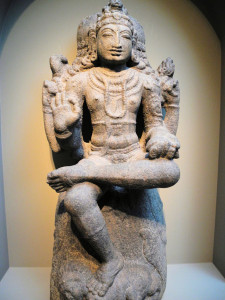 Dakshinamurti – Conqueror of senses; Epitome of Truth, Wisdom and Bliss
Dakshinamurti – Conqueror of senses; Epitome of Truth, Wisdom and Bliss
Facing south on the southern wall of most Shiva temple stone images of this youthful deity is seen seated on a rock pedestal reclining against a banyan tree, preaching. The right leg dangles down and placed on demon Apasmara and the bent left leg rests on the right thigh. His two upper arms hold a snake and a trident, the right forearm shows Chinmudra, the left holds palm leaves. Dakshinamurti is celebrated in Sangam literature, Thirumurai and Agamas.
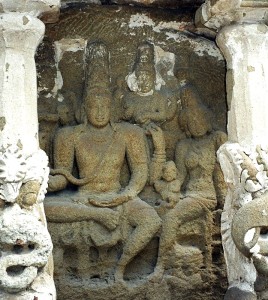 Somaskanda – Troika of Shiva, Parvati and Skanda
Somaskanda – Troika of Shiva, Parvati and Skanda
Celebrated in Sangam literature, Thirumurai, Shivagama, this four-armed Shiva sits with his left leg folded on a raised pedestal and Parvati on his left with her right knee resting on his thigh. Somaskanda holds an antelope and an axe in his upper arms and a flower bud in his left forearm. The right forearm shows the benediction mudra. Skanda dances on a lower platform in between Shiva and Parvati.
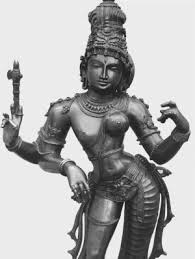 Ardhanariswara – Creation of life
Ardhanariswara – Creation of life
Ardhanariswara is the Shiva-Shakti, male-female, popular avatar of Shiva, blending force and grace that procreates life. The standing posture of the deity is half male and half female symbolizing complementarity of the sexes. Sangam literature, Thevaram, Thiruvachagam, Arunagirinathar glorify this form.
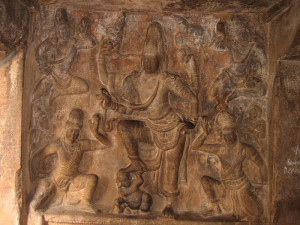 Gangadhara – One who controls the torrents of Ganga
Gangadhara – One who controls the torrents of Ganga
This avatar of Shiva stands upright with feet firmly placed on rocks, prayer beads in hand and his matted hair let loose restraining Ganga’s force as she descends on earth from heaven. Bas relief of this form is commonly found in Shiva temples, and is glorified by Thevaram, Thiruvachakam and Siddhas.
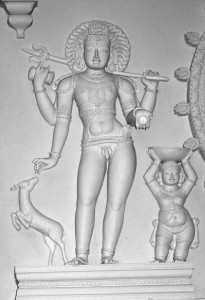 Bhikshatana – Remover of ignorance and arrogance
Bhikshatana – Remover of ignorance and arrogance
Bhikshatana is a nude provocative mendicant avatar of Shiva, carrying hand-drum or damru / udukkai and trident in his upper arms, right forearm feeding a doe and the left holding a skull cap. This form is celebrated in Thirumurai, Manickava
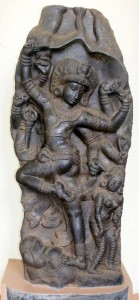 Gajasamharamurti – Taming the untamed
Gajasamharamurti – Taming the untamed
Gajasamharamurti is a fearsome avatar of Shiva tearing apart a monstrous elephant and controlling all that is hurled at him. He stands on the elephant head and wears its hides, garlands himself with the snakes, subdues the demons, carries the fire globe, tames the antelope, and makes the spikes and whips his weapons.
Veer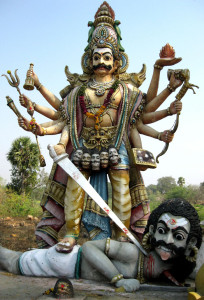 abhadra – The vengeful one
abhadra – The vengeful one
Veerabhadra is a formidable gigantic form of Shiva with his head touching the sky, the three eyes resembling three suns, and a garland of skulls. He assumes the tandavamurti over Daksha’s corpse and in his dance of destruction scorches everything in his wake. This form is celebrated in the Skanda Purana and Srimad Bhagavatam.
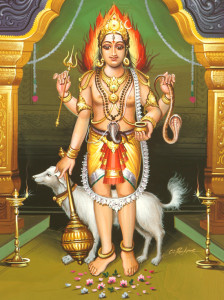 Bhairava – The fearful one; Protector of the Earth
Bhairava – The fearful one; Protector of the Earth
The guardian deity or kshetrapala, worshiped outside the main shrine in Shiva temples, who protects devotees against spirits and demons. He has protruding eyes and tusks, carriesdamru, a goad, a trident and a skull, and mounts a ferocious hound. His red matted hair forms the headdress adorned with the crescent moon and wears garlands of skulls and snakes. From eight to eighty-four forms of Bhairava are celebrated by Adi Shankara and Shaiva saints.
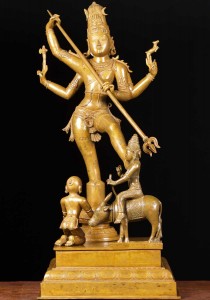 Kalasamharamurti – One who defeats Yama god of death
Kalasamharamurti – One who defeats Yama god of death
A ferocious form emanating out of a lingam holding an antelope, an axe, and a trident, with the left leg raised high to deal a mortal blow to Yama to save a devotee from death throe. The Kalasamharamurti avatar of Shiva is glorified by Thirumurai, Manickavachakar, Thirumoolar, Karaikal Ammaiyar, Periya Puranam and Thayumanavar.
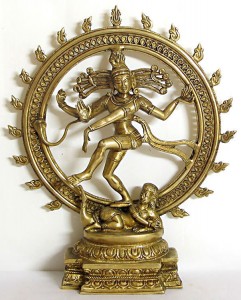 Nataraja – The cosmic dance in eternal life-death rhythm
Nataraja – The cosmic dance in eternal life-death rhythm
The dancing avatar of Shiva represents the unending cycle of death and rebirth, creation and destruction. The universe participates in his cosmic dance of destruction, tandavanritya: fire erupts, snakes spew venom, lightning flashes, and gigantic waves scale the sky, while hisdamru keeps the tempo. The dance of creation, Anandatandava follows enveloping the universe with calm and peace.
~ Subhamoy Das

